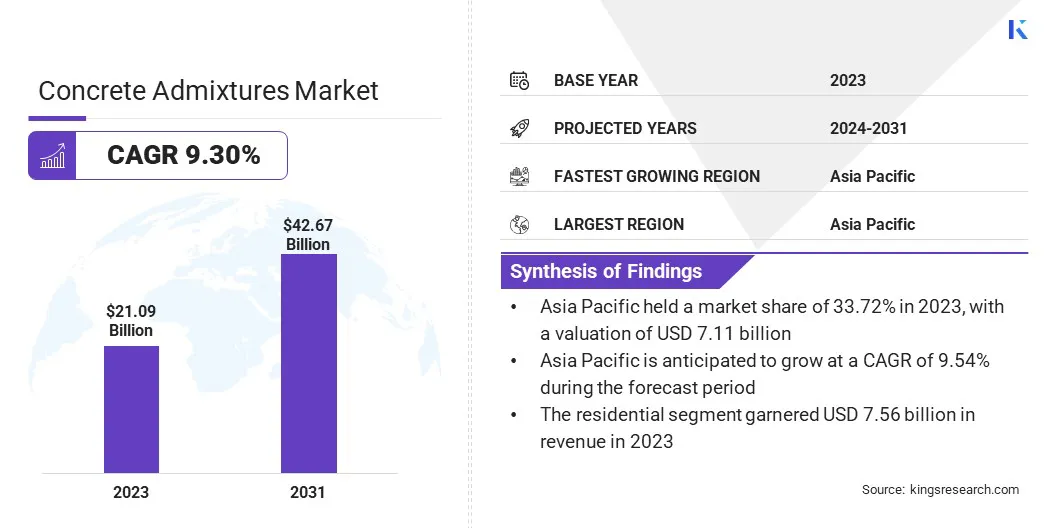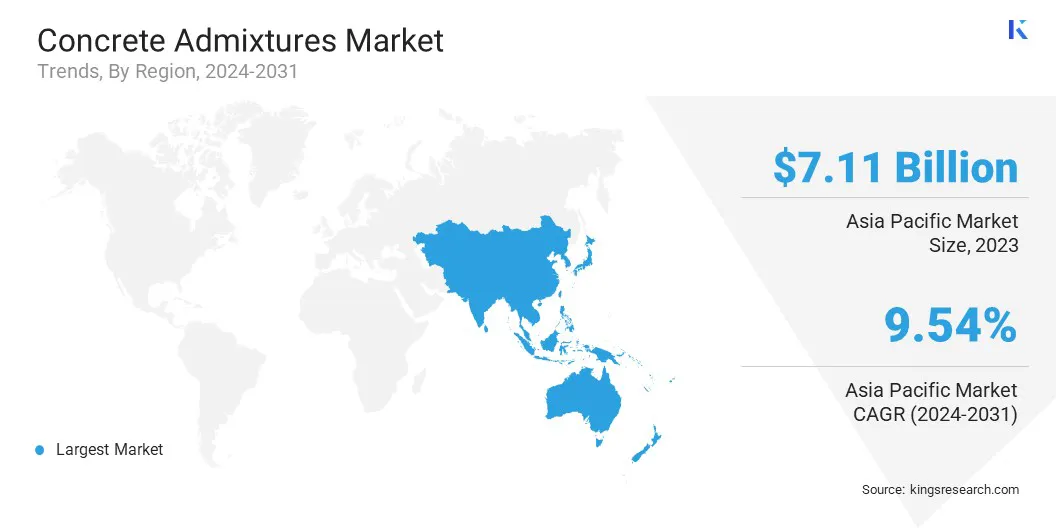Concrete Admixtures Market Size
The global Concrete Admixtures Market size was valued at USD 21.09 billion in 2023 and is projected to grow from USD 22.90 billion in 2024 to USD 42.67 billion by 2031, exhibiting a CAGR of 9.30% during the forecast period.
Rapid urbanization, particularly in developing economies, significantly impacts the expansion of the market. As populations grow and cities expand, the demand for residential and commercial construction gains pace. Concrete admixtures improve the workability, durability, and strength of concrete, making them ideal for large-scale urban construction projects.
In the scope of work, the report includes products offered by companies such as Sika AG, Saint-Gobain S.A., MAPEI, RPM International Inc., Arkema, Dow, GCP Applied Technologies, Inc., BASF, CICO Group, Kao Corporation, and others.
Technological advancements in construction materials are key factors contributing to the expansion of the concrete admixtures market. Innovations in admixture formulations reduces setting times, increases strength, and improves workability. These advancements enable more efficient and sustainable construction practices, particularly in complex and large-scale projects.
Concrete admixtures are chemical or mineral additives that are mixed with concrete to enhance its properties and performance. These additives are introduced during the mixing process to modify the properties of concrete, such as workability, strength, durability, setting time, and resistance to external environment.
Admixtures are typically used to improve the quality, functionality, and efficiency of concrete in extreme weather conditions and special construction activities, where there is a need to reduce the environmental impact of the concrete mix.

Analyst’s Review
Governments and companies are adopting targeted strategies that significantly contribute to the expansion of the concrete admixtures market. A key approach involves substantial government investments in infrastructure development, including mega-projects such as highways, bridges, high-rise buildings, and transit systems.
- The Line in Saudi Arabia is a groundbreaking futuristic project and a hallmark of the Kingdom's ambitious Vision 2030, aimed at diversifying its economy beyond oil dependency. Supported by the Public Investment Fund, the nation’s sovereign wealth fund, this initiative is projected to cost an astonishing USD 1.5 trillion. Positioned among the largest global construction endeavors, The Line will consist of two parallel skyscrapers extending over 170 kilometers through desert and mountainous landscapes.
These initiatives aim to address urbanization challenges, foster economic growth, and build resilient infrastructure to withstand adverse environments. Governments are also setting sustainability mandates, promoting the use of eco-friendly construction materials, including low-carbon concrete mixed with advanced admixtures.
Companies in the concrete admixtures industry are complementing these efforts by focusing on technological innovations to meet the growing demand for high-performance concrete. Leading manufacturers are investing in R&D to develop specialized admixtures that improve concrete’s strength, workability, and durability, in challenging construction environments.
Additionally, companies are forming strategic partnerships with construction firms and governments to provide tailored admixture solutions for complex projects.
The combined efforts of public and private sectors are driving the adoption of admixtures that cater to modern construction needs, enhancing the longevity and efficiency of infrastructure projects. These strategies are pivotal in driving the momentum of the market while addressing evolving construction demands worldwide.
Concrete Admixtures Market Growth Factors
The increasing demand for infrastructure development, especially in emerging markets, plays a pivotal role in driving the growth of the concrete admixtures market. Governments and private sectors are investing in large-scale projects such as highways, bridges, and urban buildings.
- According to the 2023 National Action Plans (NAPs) on Business and Human Rights report. the global construction industry is forecasted to expand by USD 4.5 trillion, reaching a total value of USD 15.2 trillion within the next decade. Notably, China, India, the U.S. and Indonesia are projected to account for 58.3% of this growth.
Concrete admixtures are essential in enhancing the strength, durability, and performance of concrete, which is crucial for meeting the specific requirements of these infrastructure projects. The need for more durable and high-performance concrete in such developments accelerates the expansion of the concrete admixtures market.
Construction in harsh environmental conditions, extreme temperatures, high humidity, or high chemical exposure, significantly contributes to the growth of the market. Concrete in such environments requires specific additives to improve its resistance to corrosion, freezing, and chemical attack.
The growth of construction projects, including marine structures, industrial plants, and cold-weather construction, fuels the demand for specialized concrete admixtures.
Concrete Admixtures Industry Trends
The rise of smart cities, characterized by advanced infrastructure, efficient resource management, and sustainable construction, is driving the growth of the market. Concrete admixtures offer durability and sustainability to smart city structures in urban environments.
As smart city projects require innovative and long-lasting materials, the demand for concrete with enhanced properties, such as better thermal insulation and resistance to weathering, grows. This trend is fueling the expansion of the concrete admixtures market, as they are essential for meeting the advanced requirements of smart city infrastructure.
The increasing adoption of green building practices for construction projects is significantly driving the growth of the market. As sustainable building certifications, such as LEED and BREEAM, gain prominence, construction companies afocus on reducing the environmental impact of their materials.
Concrete admixtures that promote energy efficiency, lower carbon emissions, and use recycled materials are essential for achieving these green building standards.
- In September 2024, the Indian Green Building Council (IGBC) organized the 22nd Green Building Week, in collaboration with the WorldGBC and its extensive network of Green Building Councils (GBCs). This initiative focuses on guiding the building and construction industry toward a sustainable, zero-carbon future. Operating in over 75 countries, GBCs collectively represent 60% of the global building stock and 65% of the world’s GDP, addressing 72% of emissions from the built environment through this campaign.
Segmentation Analysis
The global market has been segmented based on type, application, and geography.
By Type
Based on type, the market has been segmented into water reducing admixtures, accelerating admixtures, water proofing admixtures, retarding admixtures, air entraining admixtures, and others.
The water reducing admixtures segment led the concrete admixtures market in 2023, reaching USD 4.82 billion. Water reducing admixtures enhance the strength of concrete by imparting a lower water-to-cement ratio, which is crucial in achieving higher performance in construction projects. Water-reducing admixtures are cost-effective, which suits large-scale projects.
Their ability to optimize concrete mix designs, reduce cracking, and improve long-term durability, drives the widespread use of concrete admixtures in infrastructure, residential, and commercial construction.
By Application
Based on application, the market has been classified into residential, infrastructure, commercial, and industrial. The infrastructure segment is expected to register a robust growth at a CAGR of 7.00% over the forecast period. Development of infrastructure, such as roads, bridges, and tunnels, require concrete solutions that offer enhanced strength, workability, and resistance to harsh environmental conditions.
Concrete admixtures play a critical role in improving these properties, and therefore, are heavily utilized in the infrastructure sector. Moreover, increasing investments in infrastructure development and urbanization in emerging economies are driving the need for advanced concrete solutions.
Concrete Admixtures Market Regional Analysis
Based on region, the global market has been classified into North America, Europe, Asia Pacific, Middle East & Africa, and Latin America.

The Asia Pacific concrete admixtures market share stood at 33.72% in 2023 in the global market, with a valuation of USD 7.11 billion. Governments across Asia-Pacific are making significant investments in infrastructure development for the expansion of the market.
The Belt and Road Initiative (BRI) and ambitious national infrastructure projects in India, China, and Southeast Asia have generated a high demand for quality concrete materials.
- India's National Highway (NH) network has undergone significant development, according to the Press Information Bureau, expanding by 60% from 91,287 km in 2014 to 1,46,145 km in 2023. The length of four-lane highways has grown substantially, increasing 2.5 times from 18,387 km in 2014 to 46,179 km as of November 2023. Furthermore, the rate of NH construction has witnessed a remarkable 143% improvement, advancing from 12.1 km per day in 2014 to 28.3 km per day, highlighting the country's efforts to enhance its transportation infrastructure.
Concrete admixtures are crucial in meeting the performance and durability requirements of large-scale infrastructure projects, further driving market growth.
The swift pace of urbanization across the Asia-Pacific is a key driver for the growth of the concrete admixtures market. As cities expand and infrastructure projects proliferate, the demand for durable and high-performance concrete is expected to rise. Concrete admixtures enhance the properties of concrete, enabling it to meet specific requirements of large-scale residential, commercial, and industrial developments.
Europe is poised for significant growth at a robust CAGR of 9.36% over the forecast period. The aging infrastructure across Europe is driving the demand for renovation and maintenance. Many European countries are focusing on restoring bridges, roads, and other essential infrastructure.
- The World Green Building Council reports that 24 European cities (Madrid, Rome, and Zagreb, among others)have joined efforts to explore how assessing the holistic benefits of renovation can advance their climate change initiatives. These cities have become part of the EU-funded BUILD UPON2 project. This initiative leverages the BUILD UPON2 Framework supporting the EU’s Renovation Wave—a strategy to double the bloc’s renovation rate by 2030.
Concrete admixtures are vital in these projects, as they enhance the durability, repairability, and longevity of concrete used in restoration work.
Europe is investing in smart city development and infrastructure modernization. These projects require advanced construction materials that meet high-performance standards, including sustainability, durability, and environmental compatibility. Concrete admixtures meet these demanding requirements of smart city projects.
Competitive Landscape
The global concrete admixtures market report provides valuable insights with an emphasis on the fragmented nature of the industry. Prominent players focus on several key business strategies, such as partnerships, mergers and acquisitions, product innovations, and joint ventures, to expand their product portfolio and increase their market shares across different regions.
Strategic initiatives, including investments in R&D, establishment of new manufacturing facilities, and supply chain optimization, could create new opportunities for the market growth.
List of Key Companies in Concrete Admixtures Market
- Sika AG
- Saint-Gobain S.A.
- MAPEI
- RPM International Inc.
- Arkema
- Dow
- GCP Applied Technologies, Inc.
- BASF
- CICO Group
- Kao Corporation
Key Industry Developments
- Devember 2024 (Launch): Chryso, a subsidiary of Saint-Gobain launched a new range of additives for concrete producers, specifically formulated for cements containing calcined clays, EnviroMix C-Clay. These admixtures help calcined clay cements to fully realize their environmental benefits, reducing CO₂ emissions by up to 50% compared to conventional Portland cement.
- November 2023 (Expansion): Sika announced the expansion of its concrete admixtures production capacity in the U.S. Sika aims to meet the growing demand by increasing the production volumes of its Sika ViscoCrete technology at the Sealy facility. This investment supports the global trend favoring more sustainable construction, particularly the demand for concrete with lower embodied carbon.
The global concrete admixtures market has been segmented:
By Type
- Water reducing Admixtures
- Accelerating Admixtures
- Water Proofing Admixtures
- Retarding Admixtures
- Air Entraining Admixtures
- Others
By Application
- Residential
- Infrastructure
- Commercial
- Industrial
By Region
- North America
- Europe
- France
- UK
- Spain
- Germany
- Italy
- Russia
- Rest of Europe
- Asia-Pacific
- China
- Japan
- India
- South Korea
- Rest of Asia-Pacific
- Middle East & Africa
- GCC
- North Africa
- South Africa
- Rest of Middle East & Africa
- Latin America
- Brazil
- Argentina
- Rest of Latin America


